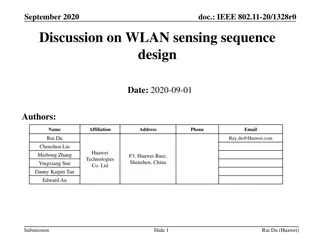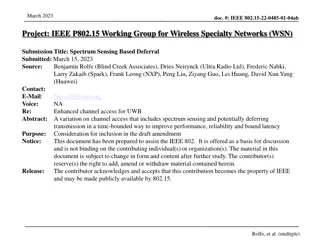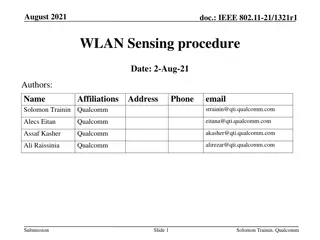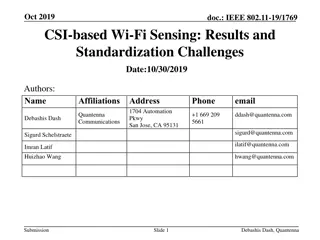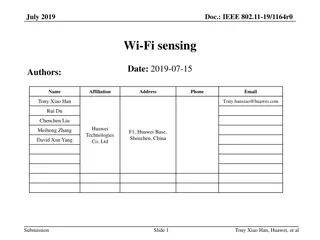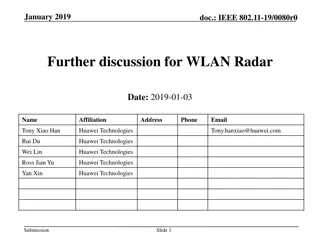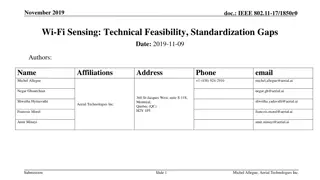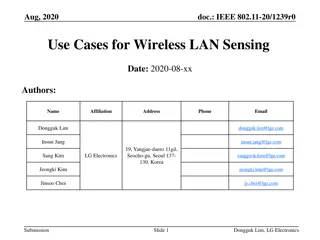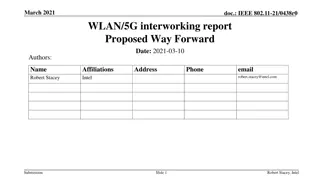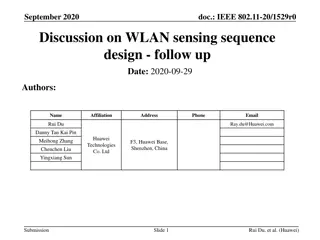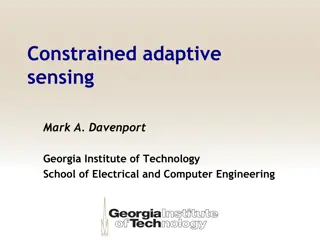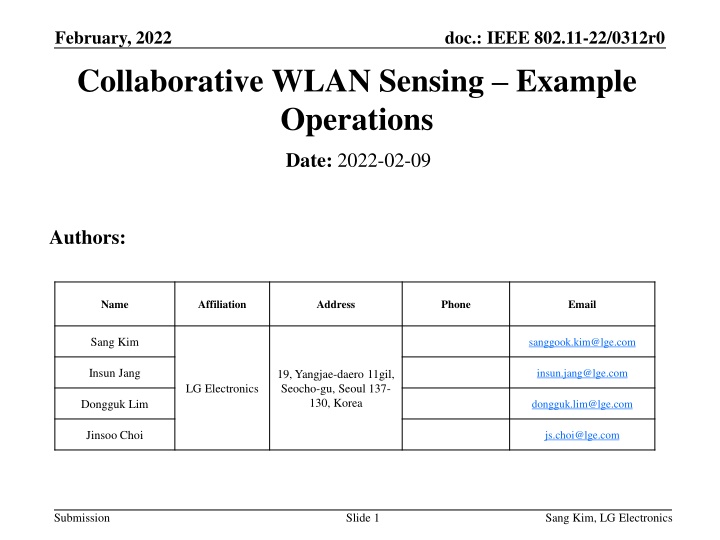
Collaborative WLAN Sensing Operations and Benefits
Explore the operations and benefits of collaborative WLAN sensing in IEEE 802.11-22/0312r0 document dated February 2022. Discover the importance of diversity in transmissions and receptions among multiple STAs for enhanced performance. The document showcases an example operation using NDPA and NDP approach to illustrate the feasibility of collaborative sensing.
Download Presentation

Please find below an Image/Link to download the presentation.
The content on the website is provided AS IS for your information and personal use only. It may not be sold, licensed, or shared on other websites without obtaining consent from the author. If you encounter any issues during the download, it is possible that the publisher has removed the file from their server.
You are allowed to download the files provided on this website for personal or commercial use, subject to the condition that they are used lawfully. All files are the property of their respective owners.
The content on the website is provided AS IS for your information and personal use only. It may not be sold, licensed, or shared on other websites without obtaining consent from the author.
E N D
Presentation Transcript
February, 2022 doc.: IEEE 802.11-22/0312r0 Collaborative WLAN Sensing Example Operations Date: 2022-02-09 Authors: Name Affiliation Address Phone Email Sang Kim sanggook.kim@lge.com Insun Jang insun.jang@lge.com 19, Yangjae-daero 11gil, Seocho-gu, Seoul 137- 130, Korea LG Electronics Dongguk Lim dongguk.lim@lge.com Jinsoo Choi js.choi@lge.com Submission Slide 1 Sang Kim, LG Electronics
February, 2022 doc.: IEEE 802.11-22/0312r0 Introduction In [1] and [2], the importance of cooperating multiple STAs in terms of performance are noted. In order to obtain certain performance, diversity transmissions and receptions of sensing signal among multiple STAs are crucial. In [3 - 5], we considered the WLAN sensing in which multitude of Wi-Fi devices are involved and collaborated termed as collaborative WLAN sensing and possible benefits are also addressed in addition to overhead to achieve them. Full benefits of diversity transmissions and receptions can be achieved. In this contribution, we illustrate one possible example operation of collaborative WLAN sensing using NDPA and NDP approach. Submission Slide 2 Sang Kim, LG Electronics
February, 2022 doc.: IEEE 802.11-22/0312r0 Introduction (Cont d) The main purpose of this contribution is to show that collaborative sensing is feasible using existing approach. Straw Poll in [5] is modified and reintroduced. Submission Slide 3 Sang Kim, LG Electronics
February, 2022 doc.: IEEE 802.11-22/0312r0 Brief Recap Configurations: Example configuration: One initiator (AP) and two responders. AP is triggering the sensing transmissions and requesting feedbacks. Sensing transmission and feedback may be measurement instance-based [3] when a session consists of multiple measurement instances. Illustration is based on measurement instance- based. Each measurement instances has sensing measurement and feedback phases. Sensing Initiator (AP) Sensing Responder 2 Sensing Responder 1 A WLAN sensing procedure may be comprised of multiple sensing measurement instances (Motion 14). Submission Sang Kim, LG Electronics Slide 4
February, 2022 doc.: IEEE 802.11-22/0312r0 Brief Recap (Cont d) Configurations: Sensing Initiator (AP) Sensing Initiator (AP) Sensing Transmitter Sensing Responder 2 Sensing Responder 2 Sensing Responder 1 Sensing Responder 1 Sensing Receiver Sensing Receiver 1st measurement instance: Transmission 1st measurement instance: Feedback Initiator transmits and two responders receive. Available channel information: Initiator to responder 1 and initiator to responder 2 Two responders feedback the measurements to initiator. Submission Sang Kim, LG Electronics Slide 5
February, 2022 doc.: IEEE 802.11-22/0312r0 Brief Recap (Cont d) Configurations: Sensing Receiver Sensing Initiator (AP) Sensing Initiator (AP) Sensing Responder 2 Sensing Responder 2 Sensing Responder 1 Sensing Responder 1 Sensing Transmitter Sensing Receiver 2nd measurement instance: Transmission 2nd measurement instance: Feedback Responder 1 transmits, initiator and responder 2 receive. Available channel information: Responder 1 to initiator and responder 1 to responder 2. Responder 2 feedbacks channel measurement between responder 1 and itself to initiator. Submission Sang Kim, LG Electronics Slide 6
February, 2022 doc.: IEEE 802.11-22/0312r0 Example Operation Assumptions: 3 STAs: AP, STA 1, and STA 2. Initiator: AP. AP is responsible for pairwise security key. Security key may be used for data encryption in measurement reporting. Measurement instances: 2 Transmitter: AP and STA 1 in order. AP triggers sensing transmission. AP triggers a receiver(s) to transmit measurement report to AP (initiator). Channel reciprocity is assumed. Submission Slide 7 Sang Kim, LG Electronics
February, 2022 doc.: IEEE 802.11-22/0312r0 Example Operation (Cont d): Measurement Instance 1 Sensing NDPA Response Response Request Request NDP AP Sensing NDPA Response Request NDP STA 1 Sensing NDPA Response Request NDP STA 2 Each receiver is to report the measurement(s) (measurement results) to initiator (Request- Response). Sensing NDPA may carry information on transmitter and receiver(s). In this example, AP is the transmitter of sensing transmission, and STA 1 and STA 2 are receivers. STA 1 STA 1 AP AP STA 2 STA 2 Submission Slide 8 Sang Kim, LG Electronics
February, 2022 doc.: IEEE 802.11-22/0312r0 Example Operation (Cont d): Measurement Instance 2 Sensing NDPA Response Request NDP NDP AP Sensing NDPA STA 1 NDP NDP Sensing NDPA Request Response NDP NDP STA 2 Sensing NDPA may carry information on transmitter and receiver(s). In this example, STA 1 is the transmitter of sensing transmission, and AP and STA 2 are the receivers. It s assumed that STA 2 obtained the time and Tx parameters of NDP transmission in advance. AP obtains measurement between itself and STA 1 by the transmission from STA 1. No explicit measurement report from STA 1 required. If required, then STA 1 transmits it after NDP transmission. Then AP (initiator) sends request to STA 2. STA 2 feedbacks the measurement between STA 1 and itself. STA 1 STA 1 AP STA 2 AP Channel information between STA 1 and STA 2 STA 2 Submission Slide 9 Sang Kim, LG Electronics
February, 2022 doc.: IEEE 802.11-22/0312r0 Considerations Q: How does STA 2 anticipate the transmission from STA 1 and corresponding information? A: One design approach is to use measurement setup phase. During the measurement setup phase, an initiator can decide which STA(s) will be a transmitter and which STA(s) will be a receiver per measurement instance, and its corresponding information for transmission can also be determined. This information can be delivered to all STAs being involved in the following measurement phase at the end of measurement setup phase by measurement setup ID(s). Similar approach may be considered in session setup phase. Which approach to take is TBD. Submission Slide 10 Sang Kim, LG Electronics
February, 2022 doc.: IEEE 802.11-22/0312r0 Considerations (Cont d) Q: How may security context for collaborative sensing be set up? A: One design approach is to use session setup phase. As already included in SFD, the session setup is pairwise between two STAs. After each session setup between an initiator and a STA(the secure connection is established), a group key for sensing can be delivered by using the established secure link (i.e., GTK), so that the STAs in collaborative sensing can share the key information by secured manner and use this for peer to peer transmission once they get it. This is similar to the group (multicast) key in IEEE 802.11(12.7 Keys and key distribution). Also more than one group keys may be generated to serve the seamless service regardless of STAs In/Out from the group. When there is a change in group members, e.g., some STAs are exited from collaborative sensing due to some reasons, another group key already generated may be used to replace the one used before exiting. Slide 11 Submission Sang Kim, LG Electronics
February, 2022 doc.: IEEE 802.11-22/0312r0 Considerations (Cont d) Pairwise secure link establishment and session setup AP Group key delivery to each STA (by using the secure link) 1 1 P2P transmission 2 2 3 STA 1 STA 2 Submission Slide 12 Sang Kim, LG Electronics
February, 2022 doc.: IEEE 802.11-22/0312r0 Summary WLAN sensing has drawn increasing attention due to its possible and potential opportunities to create many applications such as in home security, health care, enterprise, and building automation/management markets, etc. In this contribution, we illustrated an example operation of collaborative sensing and addressed questions raised. Submission Slide 13 Sang Kim, LG Electronics
February, 2022 doc.: IEEE 802.11-22/0312r0 References [1] 11-19/1416r0, Wi-Fi Sensing: Cooperation and Standard. Support. [2] 11-19/1551r1, Wi-Fi Sensing in 60GHz band: Usage models, Performance and What is need in 802.11 Standard [3] 11-20/1533r0, Collaborative WLAN Sensing. [4] 11-21/0145r5, Collaborative WLAN Sensing Follow Ups. [5] 11-21/1926r0, Collaborative WLAN Sensing Definition and Operational Scenarios. Submission Slide 14 Sang Kim, LG Electronics
February, 2022 doc.: IEEE 802.11-22/0312r0 SP Do you support to adopt the following definition of collaborative WLAN sensing into SFD: WLAN sensing in which a sensing procedure may be comprised of multiple sensing measurement setups over which the same set of more than one sensing responder STAs is maintained, but their participation and/or roles as a transmitter and a receiver for a measurement instance may be configured by multiple measurement setup IDs in coordinated way. The measurement result among sensing responders that are non-AP STAs may be delivered to the sensing initiator that is AP (Details are TBD). The same set of AID and/or UID is maintained in collaborative sensing. Multiple measurement setup IDs may be maintained until explicitly or implicitly terminated. Submission Slide 15 Sang Kim, LG Electronics




